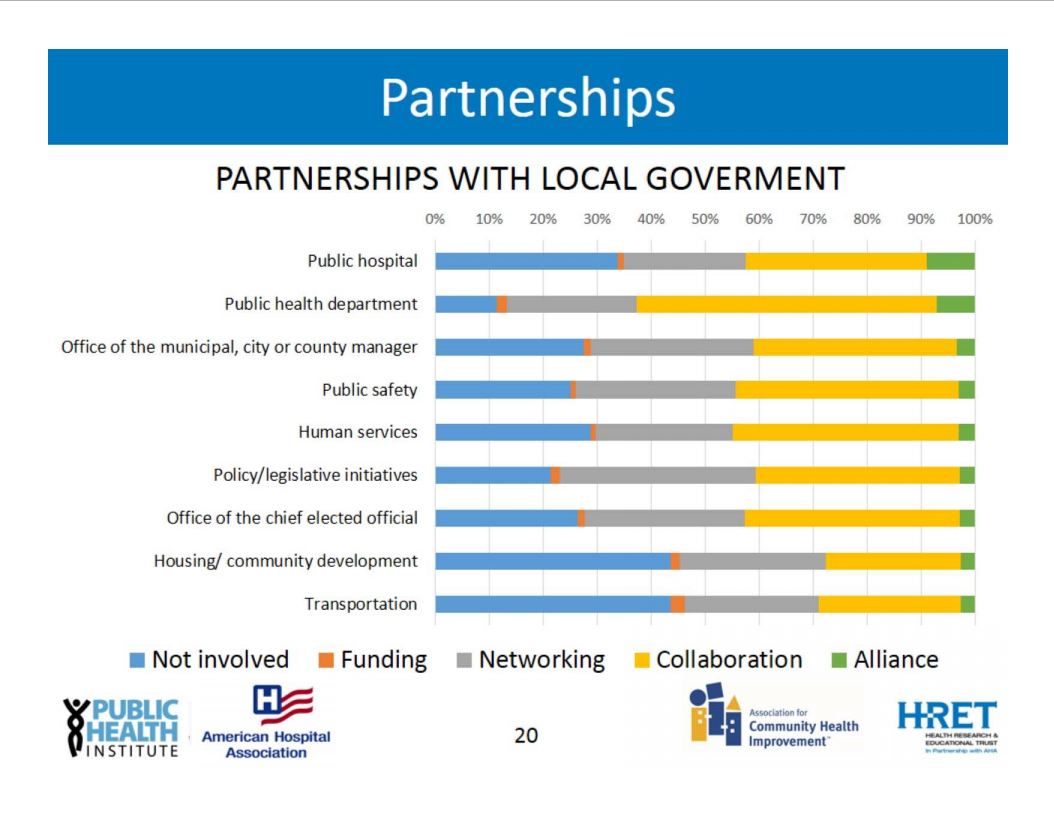
Press Release
85% of Hospitals Committed to Population Health, says AHA/PHI National Survey
-
Issues
Population Health -
Expertise
Research – Survey

As the healthcare sector continues to go through tremendous transformation, an overwhelming majority of hospitals now voice a strong commitment to population health, according to a new national survey of hospitals conducted by the American Hospital Association’s (AHA) Association for Community Health Improvement (ACHI) and Health Research & Educational Trust, in partnership with the Public Health Institute (PHI). Eighty five percent of responding hospitals reported “strong” or “total” commitment to population health, or have population health in their vision statement.
Five years after the passage of the Affordable Care Act (ACA), care delivery and payment reforms are slowly transitioning the healthcare system from a fee-for-service model to one that values — and only pays for — health outcomes, not just the provision of services. New financial incentives can reward healthcare delivery systems that collaborate and invest in efforts to address the root causes of disease, many of which are not medical, but socioeconomic–such as education, access to healthy foods and economic opportunity.
“I have spent my career jointly working on behalf of hospitals and working on behalf of public health. We each have so much to learn from each other–I am encouraged to see that synergy is beginning to happen,” said Mary A. Pittman, DrPH, president and CEO of the Public Health Institute (PHI), and former head of AHA’s Health Research and Educational Trust. “Providing excellent clinical care for patients remains essential, but hospitals are also in a strong position to engage in efforts in the broader community that address factors that cause illness in the first place.”
The ACHI/PHI survey sought to quantify hospitals engagement in population health efforts. The survey was mailed to over 6,000 hospitals across the U.S.; 1,418 (or 22%) responded. Takeaways include:
Hospitals are committed to population health.
- 85% of responding hospitals reported “strong” or “total” commitment to population health, or have population health in their vision statement.
- 90% “agreed” or “strongly agreed” that population health was aligned with their mission.
Hospitals seek collaboration and partnership.
- 69% reported being part of a community-wide coalition.
- Over 80% agreed or strongly agreed that they had strong collaborations with community organizations. The most common partnerships were with public health departments, chambers of commerce, health insurance companies and community clinics.
There is more to be done.
- Less than 20% “strongly agreed” that their hospital had programs to address the socioeconomic determinants of health.
- Some strong, potential partners have yet to be brought to the table. Hospitals were least likely to collaborate with housing/community development and transportation allies.
A barrier may be an inconsistent understanding of the term “population health.” Many in healthcare use the term to refer to improving clinical care management for a specific “panel” of patients or “covered lives.” Survey responses reflected this dual understanding of the term: Hospitals were as likely to consider their “population” to be the patients that utilize their health system as the broader population in their geographic service area.
Under its Population Health Innovation Lab (PHIL), PHI has worked on numerous projects with non-profit hospitals who are deepening their work in population health. PHI has provided data tools and services to help non-profit hospitals complete federally required community health needs assessments (CHNAs) with an emphasis on identifying vulnerable and “hot spot” populations. Through the Alignment for Health Equity and Development (AHEAD) initiative, PHI is working in five communities across the country, forging alliances between hospitals, businesses, public health agencies and community development institutions to make collaborative and coordinated investments in community health improvement. PHI’s Build Healthy Places Network is advancing partnerships between the health and community development sectors to improve health in low-income communities.
“We want to work with hospitals as they leverage their resources – and work with new partners, in new ways – to build health in the community,” continued Pittman. “Working with a community development agency to bring affordable housing or jobs into a low-income community may seem out of the typical purview of a hospital, but that may have a dramatic impact on health in that community over the long-run. In today’s healthcare environment the organizations that can do that effectively – produce healthier populations – will be the ones that thrive.”
More Updates


Physician’s Weekly: Study Using Data from PHI’s California Cancer Registry Explores How Ethnicity Impacts Mortality in Early-Onset Colorectal Cancer

How PHI’s California Overdose Prevention Network is Helping to Prevent Opioid Overdoses in San Benito, CA

Psychiatric News: How PHI’s CA Bridge is Fighting the Opioid Crisis in the ED
Work With Us
You change the world. We do the rest. Explore fiscal sponsorship at PHI.
Support Us
Together, we can accelerate our response to public health’s most critical issues.
Find Employment
Begin your career at the Public Health Institute.

